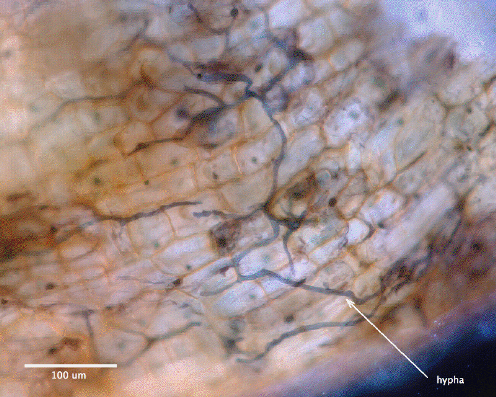Interactions
Ginkgo biloba is a unique tree in that it doesn’t
have very many interactions with other organisms. The Ginkgo
tree doesn’t require these interactions because, as stated in
HABITAT & GEOGRAPHY, G. biloba is very resistant to
insects, pollution, fungicides, bacteria, and most diseases.
Mutualistic Symbioses:
The Ginkgo tree is
usually known to only have one mutualistic symbiosis and that is
with its fungal friends from the phylum Glomeromycota. (Glomeromycota
is a specific phylum of fungi that is known to form mutualistic symbioses
with many types of plant species.) Specifically, Ginkgo biloba
interacts with a species of the Vesicular-arbuscular mycorrhiza, but
it is sometimes referred to as the more general classification, Endotrophic mycorrhiza. Two examples of Vesicular-arbuscular
mycorrhizas are Glomus fasciculatum and Glomus intraradices.
Species of Vesicular-arbuscular mycorrhizas actually go into
the roots of the Ginkgo biloba and provide the tree with
nutrients while the tree provides the fungus with carbon
compounds, such as glucose. Are you interested in learning more
about all different types of fungi? Check out
TOM VOLK'S WEBPAGE completely dedicated to fungi!

** The picture above shows a microscopic image of a Ginkgo
biloba root complete with a labeled hypha. The hypha
is from a specific fungus that has a mutualistic symbiosis with
this Ginkgo biloba plant. This wonderful picture was taken by
Matthew Foltz.
Don’t forget, Ginkgo biloba is a plant, so it also has a mutualistic symbiosis with us! We breathe out carbon dioxide for it to use during photosynthesis and we breathe in the oxygen it produces.
Predation/ Parasitism:
Pretator/prey interactions, as well as parasitic
interaction, are not very common among Ginkgo biloba. The leaves are toxic to
most insects and therefore not many insects, nor bacteria,
choose to feed or live on this tree.
Competition:
As an adult, Ginkgo biloba doesn’t have too much competition
for light, however, a little seedling has to fight pretty hard in order to have
enough water and sunlight
to grow. Some species the Ginkgo tree has to compete with are
the
Eastern White Pine, the
Cottonwood tree, and the
Sugar Maple.
Now that you know what interactions Ginkgo biloba
has with other organisms, visit NUTRITION to learn how Ginkgo biloba obtains its food!
